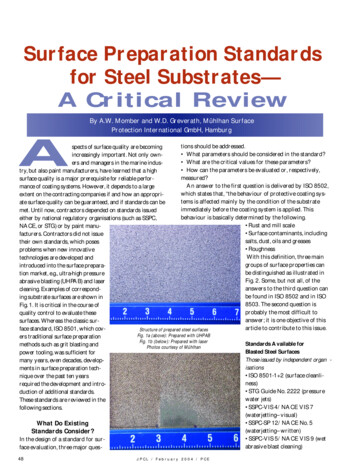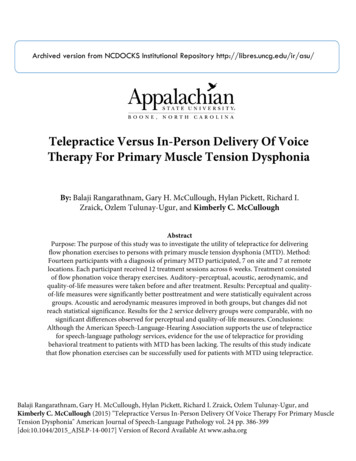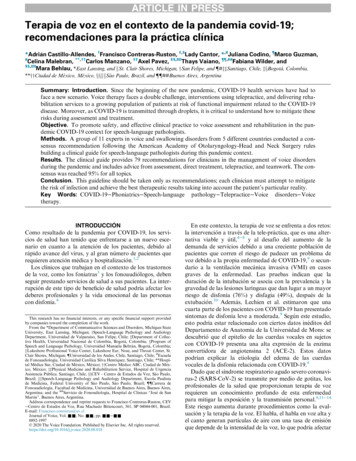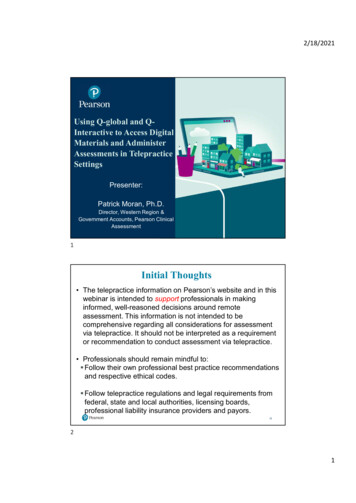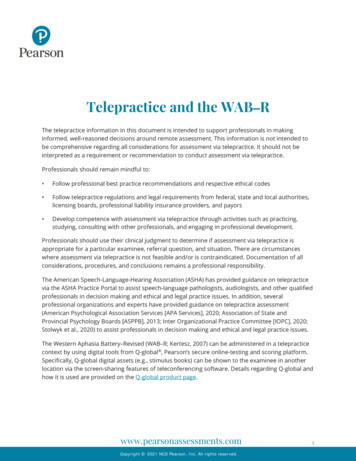
Transcription
Telepractice and the WAB–RThe telepractice information in this document is intended to support professionals in makinginformed, well-reasoned decisions around remote assessment. This information is not intended tobe comprehensive regarding all considerations for assessment via telepractice. It should not beinterpreted as a requirement or recommendation to conduct assessment via telepractice.Professionals should remain mindful to: Follow professional best practice recommendations and respective ethical codes Follow telepractice regulations and legal requirements from federal, state and local authorities,licensing boards, professional liability insurance providers, and payors Develop competence with assessment via telepractice through activities such as practicing,studying, consulting with other professionals, and engaging in professional development.Professionals should use their clinical judgment to determine if assessment via telepractice isappropriate for a particular examinee, referral question, and situation. There are circumstanceswhere assessment via telepractice is not feasible and/or is contraindicated. Documentation of allconsiderations, procedures, and conclusions remains a professional responsibility.The American Speech-Language-Hearing Association (ASHA) has provided guidance on telepracticevia the ASHA Practice Portal to assist speech-language pathologists, audiologists, and other qualifiedprofessionals in decision making and ethical and legal practice issues. In addition, severalprofessional organizations and experts have provided guidance on telepractice assessment(American Psychological Association Services [APA Services], 2020; Association of State andProvincial Psychology Boards [ASPPB], 2013; Inter Organizational Practice Committee [IOPC], 2020;Stolwyk et al., 2020) to assist professionals in decision making and ethical and legal practice issues.The Western Aphasia Battery–Revised (WAB–R; Kertesz, 2007) can be administered in a telepracticecontext by using digital tools from Q-global , Pearson’s secure online-testing and scoring platform.Specifically, Q-global digital assets (e.g., stimulus books) can be shown to the examinee in anotherlocation via the screen-sharing features of teleconferencing software. Details regarding Q-global andhow it is used are provided on the Q-global product page.www.pearsonassessments.comCopyright 2021 NCS Pearson, Inc. All rights reserved.1
A spectrum of options is available for administering this assessment via telepractice; however, it isimportant to consider the fact that the normative data were collected via in-person assessment.Telepractice is a deviation from the standardized administration, and the methods and approachesto administering it via telepractice should be supported by research and practice guidelines whenappropriate.Professionals engaging in telepractice assessment may train facilitators to work with them on aregular basis in order to provide greater coverage to underserved populations (e.g., only twoprofessionals within a 500-mile radius). Professional and nonprofessional facilitators typically do notremain in the room with the examinee throughout the testing session. The examiner should plan tominimize (as much as possible) the need for the facilitator to remain in the room. In rare cases whenthe facilitator must remain in the room, they should do so passively and unobtrusively; they shouldmerely monitor and address the examinee’s practical needs, as well as any technological oradministrative issues as necessary. The facilitator’s role should be defined clearly by the examiner.The facilitator should only perform those functions the examiner approves and deems necessary. Inany case, if a facilitator is necessary it is preferred that the facilitator remain accessible.Conducting Telepractice AssessmentConducting a valid assessment in a telepractice service delivery model requires an understanding ofthe interplay of a number of complex issues. In addition to the general information on Pearson’stelepractice page, examiners should address five factors (Eichstadt et al., 2013) when planning toadminister and score assessments via telepractice:1. Telepractice Environment & EquipmentAssessment Materials & ProceduresExaminee ConsiderationsExaminer ConsiderationsOther Considerations1. Telepractice Environment & EquipmentComputers and ConnectivityTwo computers with audio and video capability and stable internet connectivity—one for theexaminer and one for the examinee—are required. A web camera, microphone, and speakers orheadphones are required for both the examiner and the examinee. A second computer screen orsplit-screen format on a large computer monitor for the examiner is helpful to allow a view of aPearson-delivered digital manual or administration directions, but the examiner can also use thepaper format manual or administration directions. The second computer screen or large screen alsotends to make sharing test content more straightforward for the examiner.www.pearsonassessments.comCopyright 2021 NCS Pearson, Inc. All rights reserved.2
Image/Screen SizeWhen items with visual stimuli are presented, the digital image of the visual stimuli on theexaminee’s screen should be at least 9.7” measured diagonally, similar to an iPad or iPad Air .Because some teleconferencing software shrinks the size of images, the image size should beverified in the initial virtual meeting. It is recommended that computer screens used forteleconference assessment be at least 15” measured diagonally. Smaller screens, such as those ofiPad minis, small tablet PCs, and smartphones, are not allowed for examinee-facing content, asthese have not been examined empirically and may affect stimulus presentation, examineeresponse, and validity of the test results. Similarly, presenting stimuli on extremely large screens hasnot been examined, so the same precaution applies. At the beginning of the testing session, theexaminer may ask for a peripheral camera or device (as described later in this section) to be aimedat the examinee’s screen to ensure that the examinee’s screen is displaying images in the correctaspect ratio and not stretching or obscuring the stimuli image.Audio ConsiderationsHigh-quality audio capabilities are required during the administration. An over the head, two-ear,stereo headset with attached boom microphone is recommended for both the examiner andexaminee. Headphones with a microphone may be used if a headset is not available. An embeddedmicrophone in an HD camera is possible, but not preferred, especially for the Repetition, Namingand Word Finding tasks, Reading Commands, Spelling, and Reading Irregular and Non-Wordssubtests.The examiner should test the audio for both the examiner and examinee in the initial virtualmeeting and at the beginning of the testing session to ensure a high-quality audio environment ispresent. Testing the audio should include an informal conversation before the administration wherethe examiner is listening for any clicks, pops, or breaks in the audio signal that distort or interruptthe voice of the examinee. The examiner should also ask if there are any interruptions or distortionsin the audio signal on the examinee’s end. Any connectivity lapses, distractions, or intrusions thatoccurred during testing should be reported.Audiovisual DistractionsAs with any testing session, the examiner should do everything possible to make sure theexaminee’s environment is free from audio and visual distractions. If the examiner is unfamiliar withthe examinee’s planned physical location, a visual tour of the intended testing room should be givenduring the initial virtual meeting. The examiner can then provide a list of issues to address totransform the environment into one suitable for testing. For example, remove distracting items,silence all electronics, and close doors. The examiner should confirm that these issues have beenaddressed at the time of testing. If possible, the examinee should be positioned facing away fromthe door to ensure the examiner can verify through the examinee’s camera that the door remainsshut and can monitor any interruptions. The examiner should confirm that all other applications onthe computer, laptop, or peripheral device are closed, the keyboard is moved aside or covered afterthe session is connected, and alerts and notifications are silenced on the peripheral device. Radios,www.pearsonassessments.comCopyright 2021 NCS Pearson, Inc. All rights reserved.3
televisions, other cellular phones, fax machines, smart speakers, printers, and equipment that emitnoise must be silenced and/or removed from the room.LightingGood overhead and facial lighting should be established for the examiner and examinee. Blinds orshades should be closed to reduce sun glare on faces and the computer screens.Teleconferencing SoftwareTeleconferencing software is required. Screen-sharing capability is required if anything other thanitems with verbal stimuli and responses are administered.VideoHigh-quality video (HD preferred) is required during the administration. Make sure the full faces ofthe examiner and the examinee are seen using each respective web camera. The teleconferencingsoftware should allow all relevant visual stimuli to be fully visible to the examinee when providinginstruction or completing items; the view of the examiner should not impede the examinee’s view ofvisual test stimuli.Peripheral Camera or DeviceA standalone peripheral camera can be used to provide a view of the session from another angle ora live view of the examinee’s progress. Alternately, a separate device (e.g., a smartphone with acamera or another peripheral device) can be connected to the teleconference and set in a stableposition to show the examinee’s pointing or written responses. The device’s audio should besilenced and microphone should be muted to prevent feedback. The examiner should guidepositioning of the peripheral camera/device before administering any subtest with written, pointing,or gestured responses (refer to Table 1) so that the examiner can see that the examinee’s real-timeresponses are captured.In a typical telepractice session, it is more feasible to make a document or moveable cameraavailable in the examinee’s location. However, when physical distancing is necessary, the onlycamera available may be a stationary camera integrated into the examinee’s laptop or computerscreen. It is unrealistic to expect examinees to have document cameras within their homes. It maybe necessary for examiners to think creatively about how to use a smartphone or other device in theexaminee’s location to gain a view of the examinee’s progress in a writing task or when pointing at ascreen. Before attempting this with an examinee, the examiner should work to become fluid andcompetent at directing examinees in these methods, which can require extensive practice withvaried individuals and types of devices. In addition, this requires planning and practice in the initialvirtual meeting to prevent technical difficulties, and so the examinee feels confident doing this whenit is time.Online instructional videos (e.g., here) demonstrate how a smartphone may be used with commonhousehold objects (e.g., a tower or stack of books, paper weight, ruler, and rubber band or tape) tocreate an improvised document camera for use during tasks involving writing tasks. Similarly, forwww.pearsonassessments.comCopyright 2021 NCS Pearson, Inc. All rights reserved.4
multiple choice tasks, some examinees tend to point to responses rather than say the number orletter corresponding to their response, and other tasks (e.g., Picture Completion, Arithmetic pictureitems; see Table 1) require the examinee to point at the stimuli. In this situation, other everydayhousehold objects (e.g., books) could be used to form an improvised stand upon which to positionthe device to provide a second-angle view of the examinee pointing at the screen. A simple mirrorbehind the examinee has been used successfully to observe pointing responses. Typically, devicesprovide the best view of the examinee’s screen and pointing responses when positioned inlandscape orientation. While using additional cameras or devices/objects may not be an optimalsolution for telepractice, it can be functional if executed well.Screen-Sharing Digital ComponentsDigital components are shared within the teleconferencing software as specified in Table 1. Thereare two ways to view digital components in the Q-global Resource Library: through the pdf viewer inthe browser window or full screen in presentation mode. Always use full screen (i.e., presentation)mode for digital components viewed by the examinee. This provides the cleanest presentation oftest content without on-screen distractions (e.g., extra toolbars). Refer to Using Your Digital Assets onQ-global in the Q-global Resource Library for complete directions on how to enter presentationmode.2. Assessment Materials & ProceduresTest Item SecurityThe examiner is responsible for ensuring test item security is maintained, as outlined in the Termsand Conditions for test use. The examiner should address test security requirements with theexaminee (and facilitator, if applicable) during the informed consent process. The examiner shouldmake it clear to the examinee/caregivers that the video should not be captured, photos should notbe taken, and stimuli should not be copied or recorded, as this is a copyright violation. Theexaminee must agree that they will not record (audio or visual) or take photos or screenshots of anyportion of the test materials or testing session, and not permit anyone to observe the testingsession or be in the testing room (except for a facilitator, when necessary). Any test-relatedmaterials used in the testing session must be returned to the examiner.DisruptionsThe examiner should record any and all atypical events that occur during the testing session. Thismay include delayed audio or video, disruptions to connectivity, the examinee being distracted byexternal stimuli, and any other anomalies. These can be noted on the record form and should beconsidered during interpretation and described in the written report. Refer to Other Considerationsfor guidance on report writing.www.pearsonassessments.comCopyright 2021 NCS Pearson, Inc. All rights reserved.5
ManipulativesBlock Design administration with a professional or trained facilitator is preferred. The blocks shouldbe provided to the facilitator before the testing session.Manipulatives also will be needed on the examiner and examinee sides during the remoteadministration. When using the Remote-Adapted Stimulus Book via Q-global, ask the facilitator togather the following household items prior to the administration:Pen Pencil Comb Book Ball Knife Fork Spoon Cup Safety Pin Hammer Toothbrush Eraser (Pad)lock Screwdriver Key Paper Clip Watch Rubber Band Tape Matches 5–8 sheets of unlined paper TelephoneDigital AssetsThe examiner should practice using the digital assets until the use of the materials is as smooth asan in-person administration. It is not recommended that the examiner display items from paperstimulus books on a camera. Refer to Using Your Digital Assets on Q-global in the Q-global ResourceLibrary for complete directions.GesturingWhen gesturing to the stimulus books is necessary, the examiner should display them as digitalassets on-screen and point using the mouse cursor. It may on occasion be necessary for theexaminer to gesture to areas of a paper copy of a component or to show how to respond todemonstration items on the examiner’s camera. Refer to Table 1 for specific instructions by subtest.Content ConsiderationsReview Table 1 for the specific telepractice considerations for each subtest to be administered.Table 1. Specific Telepractice siderationsYes/No Questions Conversational Questions: Refer to clinician’s location [i.e., “Have youbeen here (in my office) before?”] if needed.RepetitionWord FluencySentence CompletionResponsive SpeechSpelled WordRecognitionSpelling Requires high-quality audio for examinee and examiner. Yes/No Questions Items 10–13: Refer to clinician’s location [e.g., “Arethe lights on in (my) room? Is the door closed in (my) room?”] ifneeded; make sure camera is positioned so the examinee can seethe door in the clinician’s room. Word Fluency: Use stopwatch to ensure the examinee stops at thetime limit.www.pearsonassessments.comCopyright 2021 NCS Pearson, Inc. All rights reserved.6
Subtest(s)Picture DescriptionObject NamingReading Irregular WordsReading Non-WordsAuditory WordRecognitionComprehension ofSentencesWritten Word-ObjectChoice MatchingWritten Word-PictureChoice MatchingPicture-Written WordChoice MatchingSpoken Word-WrittenWord Choice MatchingLetter DiscriminationCalculationRaven’s ColouredProgressive MatricesConsiderations Requires high-quality audio and video for examinee and examiner. Picture Description, Reading tasks: Screen-share and point with themouse to stimuli; converting to a large cursor size is preferred tohelp with vision needs of older adults. Object Naming: Show objects in front of the examiner camera. It isrecommended to also give a set of objects in an opaque bag to thefacilitator to use as directed by the examiner during theadministration. Screen-share and give mouse control to examinee, asking to movethe mouse and point to the object, word, or correct response onscreen when directed. Alternatively, place a peripheral camera/device in a stable positionthat shows examinee’s screen and/or provides a view of pointingresponse. Auditory Word Recognition, Items 39 and 41: Select alternative objectin the room if needed. Auditory Word Recognition, Item 56: Replace “Left Knee” with “LeftEyebrow” if needed. Auditory Word Recognition, Item 57: Replace “Left Ankle” with “Left Eye”if needed. Comprehension of Sentences: Complete demo item and anyappropriate corrective feedback before giving mouse control toexaminee. Ask the facilitator to make sure the examinee has the book, pen, andcomb on the table directly in front of the examinee.Sequential Commands Place peripheral camera/device in a stable position to showexaminee’s pointing/responses. Item 4: Replace “Point to the window, then to the door” with “Point tothe floor, then to the ceiling” if needed. Ask the facilitator to make sure the examinee has a pencil on thetable directly in front of the examinee.Reading Commands Place peripheral camera/device in a stable position to showexaminee’s pointing/responses. Item 4: Replace “Draw a cross with your foot” with “Draw a cross withyour finger” using the Remote-Adapted Stim Book if needed.Writing Upon RequestWriting Irregular Wordsto DictationWriting Non-Words toDictation Ask the facilitator to make sure the examinee has a piece of unlinedpaper and a pen on the table directly in front of the examinee. Place peripheral camera/device in a stable position to showexaminee’s written responses. Requires high-quality audio for examinee and examinerwww.pearsonassessments.comCopyright 2021 NCS Pearson, Inc. All rights reserved.7
Subtest(s)Writing OutputCopying a SentenceDrawingConsiderations Screen-share and point to stimuli with the mouse. Place peripheral camera/device in a stable position to showexaminee’s written responses. Writing Output: Use stopwatch to ensure the examinee stops at the 3minute time limit. Drawing: Screen-share and show stimuli if needed. Take a screenshot of the examinee’s output to save for scoring.Writing to DictationWriting Dictated WordsAlphabet and NumbersDictated Letters andNumbersApraxia Requires high-quality audio for examinee and examiner. Place peripheral camera/device in a stable position to showexaminee’s written responses. Take a screenshot of the examinee’s output to save for scoring. Writing Dictated Words: Show objects in front of the examiner cameraif needed. Ask the facilitator to make sure the examinee has relevant objects, apiece of unlined paper, and a phone on the table directly in front ofthe examinee. Place peripheral camera/device in a stable position to showexaminee’s responses. Ask a trained facilitator to assist with administration of this subtest.It is not recommended to allow an untrained facilitator to presentblocks for Block Design nor to attempt to have the examineescramble or present their own blocks.Block Design Ask the facilitator to make sure the examinee has Koh’s blocks on thetable directly in front of the examinee. Place peripheral camera/device in a stable position to showexaminee’s constructions; examiner also needs peripheral camera toshow the demonstration item. Screen-share and point to stimuli with the mouse. Use stopwatch to ensure the examinee stops at the time limit.Evaluating Equivalence EvidenceExaminers should review the current research available on equivalence between different modes ofadministration before proceeding to use remote administration of a standardized assessment withnormative data collected via in-person assessment. When reviewing the literature, the examinershould consider the input and output requirements for each task, and the evidence available fortelepractice equivalence for the specific task type. Direct evidence of equivalence for a specific taskmay be available because the task was researched in a study with results indicating no significantdifference between telepractice and in-person assessment. Indirect evidence may also be reportedin the literature for a task that is similar in construct and input/output demands to the standardizedassessment being considered for remote administration and may help determine the examiner’slevel of confidence in applying the norms. For instance, a study demonstrating direct evidence forwww.pearsonassessments.comCopyright 2021 NCS Pearson, Inc. All rights reserved.8
the Repeatable Battery for the Assessment of Neuropsychological Status (RBANS) Picture Namingsubtest also demonstrates valuable indirect evidence for the WISC-V Vocabulary and CLQT Confrontation Naming subtests because Picture Naming, Vocabulary, and Confrontation Naming allrequire brief spoken directions with pictorial stimuli inputs with open-ended spoken responseoutputs. Examiners can have more confidence that the normative scores are valid when tasks havedirect evidence showing equivalency between modes.In reviewing the literature of telepractice–in-person and digital–traditional investigations,professionals should also be mindful of the age range and population (e.g., clinical group) of theresearch study to consider relevancy for the examinee. Greater caution is recommended when onlyindirect evidence of equivalency is available for a task, or when equivalence has not beenestablished for a particular examinee’s age range and clinical condition. However, it can beinformative to consider any such available evidence when considering impact of remoteadministration on results and interpretation. Pearson Clinical Assessment is tracking andaggregating the relevant equivalence evidence for our assessments, including the age range,population, direct evidence, and indirect evidence (see Evidence for Remote Assessment). For theWAB-R in particular, a recent article by Dekhtyar and colleagues (2020) provides a direct comparisonof performance between in-person and remote administrations.Table 2 lists the input and output requirements of each task. The abbreviations in the Input andOutput column correspond to the various input and output requirements of each task, and a keyappears at the bottom of the table. For example, brief spoken directions as an input requirement isabbreviated as BSD.Table 2. Input and Output RequirementsTaskConversational QuestionsInputaSSOutputbBSRPicture DescriptionBSD, PSSPRYes/No QuestionsBSD, SSBSR (GMR)Auditory Word RecognitionSS, PS, SP, CCGMR, MC, PRSequential CommandsBSD, PM, SSGMR, PRObject NamingSS, PMBSR, ITWord FluencySSSPR, OE, TTRepetitionBSD, SSBSRBSD, SPPR, MCSpellingLetter DiscriminationSentence CompletionResponsive SpeechSpelled Word RecognitionComprehension of Sentenceswww.pearsonassessments.comCopyright 2021 NCS Pearson, Inc. All rights reserved.9
TaskReading CommandsInputaBSD, PM, SPOutputbGMR, PR, WFRWritten Word-Object ChoiceMatchingBSD, PM, PS, SPPR, MCWritten Word-Picture ChoiceMatchingBSD, PS, SPPR, MCPicture-Written Word ChoiceMatchingSpoken Word-Written Word Choice SP, SSMatchingPRWriting Upon RequestBSD, SSWFRWriting OutputSS, PSWFR, TTWriting to DictationSSWFRWriting Dictated WordsBSD, GD, PM, SSSWRDictated Letters and NumbersBSD, SSSWRCopying a SentenceSS, SPWFRApraxiaBSD, PM, SSGMR, WFRDrawingSS, SP, TPIT, WFRBlock DesignBSD, GD, MD, PM, PSGMR, ITCalculationBSD, SS, SPBSR, MC, PRRaven’s Coloured ProgressiveMatricesBSD, GD, PS, SSMC, PR, TTReading Irregular WordsBSD, SPBSRAlphabet and NumbersWriting Irregular Words toDictationWriting Non-Words to DictationReading Non-WordsNote. aInput abbreviations are: BSD Brief spoken directions, CC Color critical items, GD Gestured directions, MD Motor demonstration,PM Physical manipulatives, PS Pictorial stimuli, SP Letters, digits, or symbols in print, SS Spoken stimuli, TP Timed presentationbOutput abbreviations are: BSR Brief spoken response, GMR Gross motor response, IT Item-level time limit, MC Multiple choice, OE Open ended, PR Pointing response, SPR Spoken response, SWR Simple written response, TT Task-level time limit, WFR Written or finemotor response.www.pearsonassessments.comCopyright 2021 NCS Pearson, Inc. All rights reserved.10
3. Examinee ConsiderationsAppropriatenessThe examiner should first ensure that a telepractice administration is appropriate for the examineeand for the purpose of the assessment. Clinical judgment, best practice guidance for telepractice(e.g., ASHA Practice Portal), information from professional organizations and other professionalentities (e.g., licensing boards, legal resources, professional liability insurance providers, payors),consultation with other knowledgeable professionals, existing research, and any available federal orstate regulations should be considered in the decision-making process. Consideration should begiven to whether the necessary administrative and technological tasks involved in a telepracticesession can be accomplished without influencing results.PreparednessBefore initiating test administration, the examiner should ensure that the examinee is well-rested,able, prepared, and ready to appropriately and fully participate in the testing session.Facilitator RoleIf using a facilitator, the role of the facilitator must be explained to the examinee so participationand actions are understood.HeadsetIt may not be appropriate or feasible for some examinees to use a headset due to behavior,positioning, physical needs, or tactile sensitivities, or if a headset is not available. Clinical judgmenton the appropriate use of a headset in these situations should be used. If a headset is not utilized,the examiner’s and examinee’s microphones and speakers should be turned up to a comfortablevolume.MouseOn some teleconferencing software, the examiner can pass control of the mouse to allow theexaminee to point to indicate responses; this is an option if it is within the capabilities of theexaminee. However, best practice guidelines provide cautions about this. For example, the IOPCguidelines suggest examiners be alert throughout administration, resume control of the screen oncethe task is finished, and never leave the computer unattended while the examinee has control overthe examiner’s computer (IOPC, 2020).4. Examiner ConsiderationsPracticeDuring the telepractice setup, and before administering to any actual examinee, the examinershould rehearse the mechanics and workflow of every item in the entire test using the selectedwww.pearsonassessments.comCopyright 2021 NCS Pearson, Inc. All rights reserved.11
teleconferencing software so that the examiner is familiar with the administration procedures. Forexample, a colleague could be used as a practice examinee.Standardized ProceduresThe examiner must follow the administration procedures of in-person administration as much aspossible. For example, if a spoken stimulus cannot be said more than once in in-personadministration, the examiner must not say it more than once in a telepractice administration unlessa technical difficulty precluded the examinee from hearing the stimulus.Real-Time TroubleshootingIn order to conduct a smooth telepractice session, audiovisual needs and materials must bemanaged appropriately. The initial virtual meeting involves the examiner, examinee, and/or thefacilitator (if used), and is the opportunity for the examiner to provide information about theaudiovisual needs and materials. During the initial virtual meeting, the examiner should providetraining in troubleshooting audiovisual needs that arise during the testing session, including cameraangle, lighting, and audio checks. The examiner should provide verbal feedback to guide cameraadjustment, checking the on-screen video shown by the peripheral camera/device to provideinformation about how to reposition it until the proper view is shown. The examiner shouldemphasize that no materials should be opened until the examiner provides instructions to do so, ifapplicable. The examiner should also expect to provide verbal guidance about these issues duringthe testing session. Refer to the Telepractice Environment & Equipment section and to Table 1 forspecific subtest telepractice considerations.Collaborating With FacilitatorsIf used, the facilitator is to assist with administrative and technological tasks and not to managerapport, engagement, or attention during the testing session. The examiner should direct them notto interfere with t
licensing boards, professional liability insurance providers, and payors Develop competence with assessment via telepractice through activities such as practicing, . via the ASHA Practice Portal to assist speech-language pathologists, audiologists, and other qualified professionals in decision making and ethical and legal practice issues .



